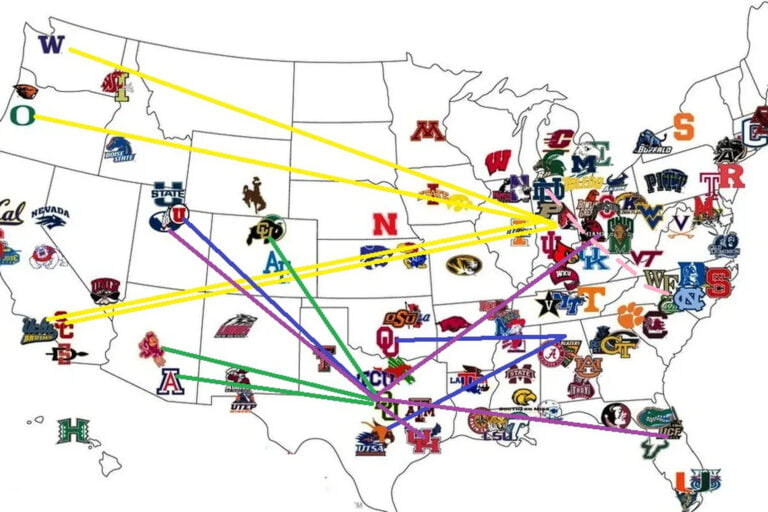With the ever-evolving landscape of college sports, the upcoming NCAA Conference Realignment in 2025 has garnered significant attention and anticipation. The shifts and changes in conference alignments can have far-reaching effects on college athletics, from rivalries to revenue distribution. Fans, players, coaches, and universities are all on the edge of their seats, waiting to see how the realignment will unfold. Speculations are rife about which schools will switch conferences and how this will impact powerhouse programs and underdogs alike. Join us as we delve into the intricate world of NCAA Conference Realignment 2025 and explore the potential implications and surprises that this transformative process may bring.
Introduction to NCAA Conference Realignment
In 2025, the landscape of NCAA Conference Realignment has been evolving rapidly, reshaping the collegiate sports scene in significant ways. Conference realignment refers to the process where collegiate conferences undergo changes in their membership, often driven by factors such as financial considerations, competitive balance, and geographic alignments.
Factors Driving Realignment
Realignment decisions are influenced by a myriad of factors, including financial stability, market expansion, media rights agreements, and competitive advantages.
Impact on Universities
The realignment can have profound effects on universities, affecting their recruitment strategies, revenue streams, and athletic programs. This forces universities to adapt to the changing landscape.

Historical Context of Conference Realignment
Conference realignment in NCAA has been a significant transformative process over the years, leading to changes in team alignments and division structures. The most recent major realignment occurred in 2025, reshaping the landscape of collegiate sports.
Impact on Traditional Rivalries
Realignment often disrupts age-old rivalries between teams, causing angst among fans and alumni. Schools that have competed for decades may find themselves in different conferences, altering the dynamics of matchups and historical significance.
Financial Considerations
Conference realignment is often driven by financial motives, with schools seeking to maximize revenue opportunities through TV contracts, bowl games, and merchandise sales. Universities may switch conferences to gain better financial stability or exposure.
Factors Influencing Conference Realignment
In 2025, the NCAA landscape is constantly evolving, heavily influenced by various factors driving conference realignment decisions.
Financial Considerations
Financial stability plays a significant role in prompting conferences to reevaluate their alignments. TV rights deals and sponsorships with major brands often dictate the direction of realignment. Institutions seek to maximize revenue opportunities to enhance their athletic programs. One such significant change is the shift towards expansion markets to tap into new revenue streams.
Competitive Balance
Strength of competition is crucial for schools striving for athletic success. Conference realignment aims to create more competitive parity to ensure each member institution has a fair shot at winning championships. Schools may switch leagues to seek better matchups or to enhance their chances of securing postseason berths.
Social and Geographic Factors
Geographical proximity and cultural alignment contribute to conference realignment decisions. Schools often consider travel costs, fan base accessibility, and rivalry preservation when determining their conference affiliations. Establishing regional rivalries can enhance fan engagement and increase attendance at athletic events.
Implications for College Athletics
With the upcoming NCAA Conference Realignment in 2025, college athletics are set to undergo significant changes that will impact various aspects of the sporting world. These changes will not only affect the participating teams but also fans, sponsors, and the overall landscape of collegiate sports.
Financial Challenges
The realignment may lead to financial challenges for smaller athletic programs as they strive to compete in more competitive conferences. This could result in budget cuts, reduced scholarships, and potential layoffs within athletic departments.
Leading universities may enjoy increased revenue streams from lucrative television contracts and sponsorships, further widening the financial gap between the haves and have-nots in college sports.
Player Transfer Dynamics
Player transfer dynamics are also expected to change post-realignment, with student-athletes opting to transfer to more prominent programs to enhance their visibility and chances of securing professional sports opportunities.
- Increased Competition: Athletes may face tougher competition within their own teams as new recruits seek to establish themselves in the reconfigured conferences.
- Change in Recruitment Strategies: Coaches and recruitment staff will need to adapt their strategies to attract top talent to their programs amidst new conference affiliations.

Predictions for NCAA Conference Realignment 2025
As we approach 2025, speculation is rife about potential NCAA conference realignment moves. With shifting dynamics in college sports, it’s crucial to analyze the possible scenarios that may unfold in the upcoming year.
Potential Power Shifts
The year 2025 could witness significant power shifts in NCAA conferences, with traditional powerhouses facing new challenges from emerging contenders. The landscape might see established teams consolidating their dominance or unexpected underdogs rising to prominence.
Regional Realignments
One possible outcome of the NCAA conference realignment in 2025 is the emphasis on regional proximity and rivalries. This could lead to conferences reorganizing based on geographic locations to reduce travel costs and enhance fan engagement. Regional realignments may create new matchups and intensify existing rivalries, adding excitement to the college sports scene.
Impact on Schools and Conferences
With the impending NCAA Conference Realignment of 2025, schools and conferences are poised for significant changes. This restructuring is expected to impact not only the NCAA but also the individual schools and conferences involved.
New Opportunities and Challenges
Schools will have the opportunity to compete in new and exciting conferences, potentially leading to increased exposure and revenue. However, this shift may also bring about challenges in terms of travel costs and logistical considerations.
Conference Alignment Strategies
Conferences will need to strategize on how to best position themselves in the new landscape. This could involve mergers, acquisitions, or even rebranding to maximize their appeal and competitiveness.
Challenges and Opportunities Ahead
The NCAA Conference Realignment in 2025 brings both challenges and opportunities for all involved stakeholders. The dynamic nature of college sports and the quest for competitive advantages have led to a series of realignments over the years.
Financial Impact
The financial implications of conference realignment can be significant. Institutions may face increased travel costs due to expanded geographical footprints, while potential revenue streams from new media markets could also arise, providing opportunities for financial growth. The financial stability of conferences will play a crucial role in determining the success of realignment strategies.
Competitive Balance
The competitive balance within conferences may be altered as powerhouse programs shift alliances, affecting the overall landscape of college sports. Rivalries may be reshaped, leading to new matchups and renewed rivalries, creating exciting opportunities for fans and players alike.
- Some programs may see increased competition, while others may benefit from a more favorable schedule.
- Recruitment strategies may need to be adjusted to remain competitive in the new conference alignments.

Frequently Asked Questions
- What is NCAA conference realignment?
- NCAA conference realignment refers to when colleges and universities change the conferences they belong to for various reasons such as competitive balance, financial considerations, and geographical alignments.
- Why is predicting the future of NCAA conference realignment important?
- Predicting the future of NCAA conference realignment can give insights into potential changes in college sports landscape, impact on rivalries, revenue distribution, and overall competitiveness of different conferences.
- What factors contribute to NCAA conference realignment?
- Factors like TV market size, academic profile, athletic success, location, and financial stability of member institutions can contribute to NCAA conference realignment decisions.
- What are some potential scenarios for NCAA conference realignment in 2025?
- Potential scenarios for 2025 NCAA conference realignment could include major conferences expanding, new conferences forming, or schools shifting allegiances based on various factors.
- How does NCAA conference realignment impact student-athletes?
- NCAA conference realignment can impact student-athletes by changing their competition level, travel demands, exposure, and overall college experience based on the conference they belong to.
Future Outlook: The Landscape of NCAA Conference Realignment 2025
In conclusion, the NCAA Conference Realignment in 2025 is set to usher in a new era of competitive dynamics and geographical shifts in collegiate sports. The potential realignments could reshape traditional rivalries while creating exciting new matchups and storylines. As schools seek to optimize revenue streams and enhance their competitive standing, conference realignment becomes an essential strategy for growth and sustainability.
While uncertainties and challenges lie ahead, the 2025 NCAA Conference realignment presents opportunities for schools to redefine their athletic identities and expand their reach to new markets. It’s clear that the landscape of collegiate athletics is constantly evolving, and these strategic moves will undoubtedly shape the future of sports in the years to come.


